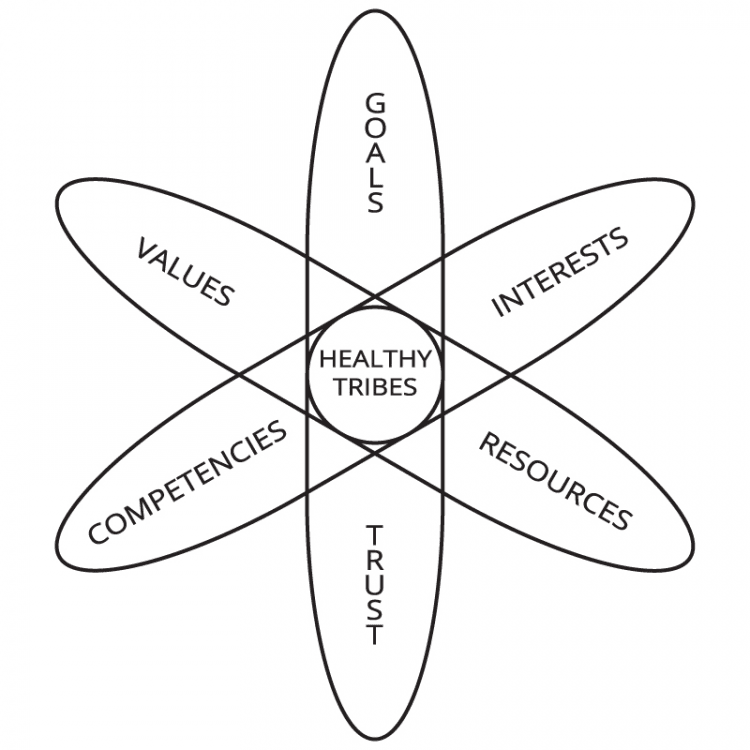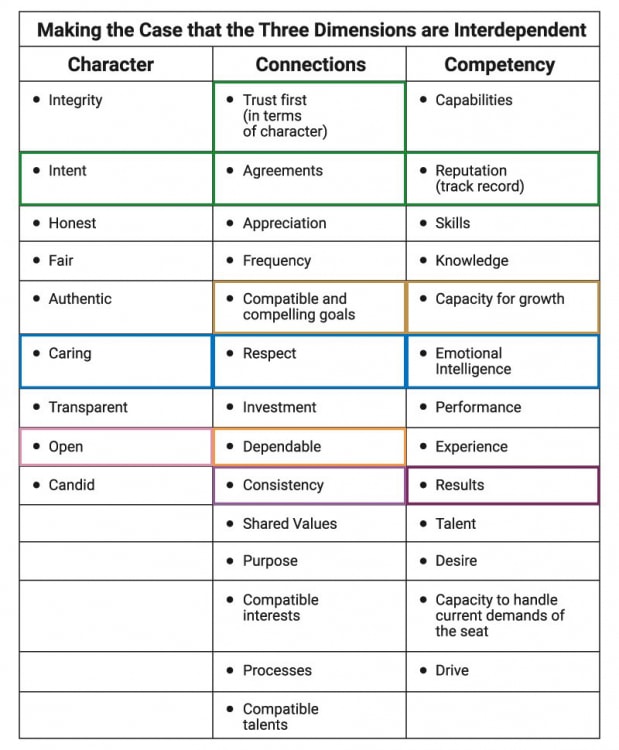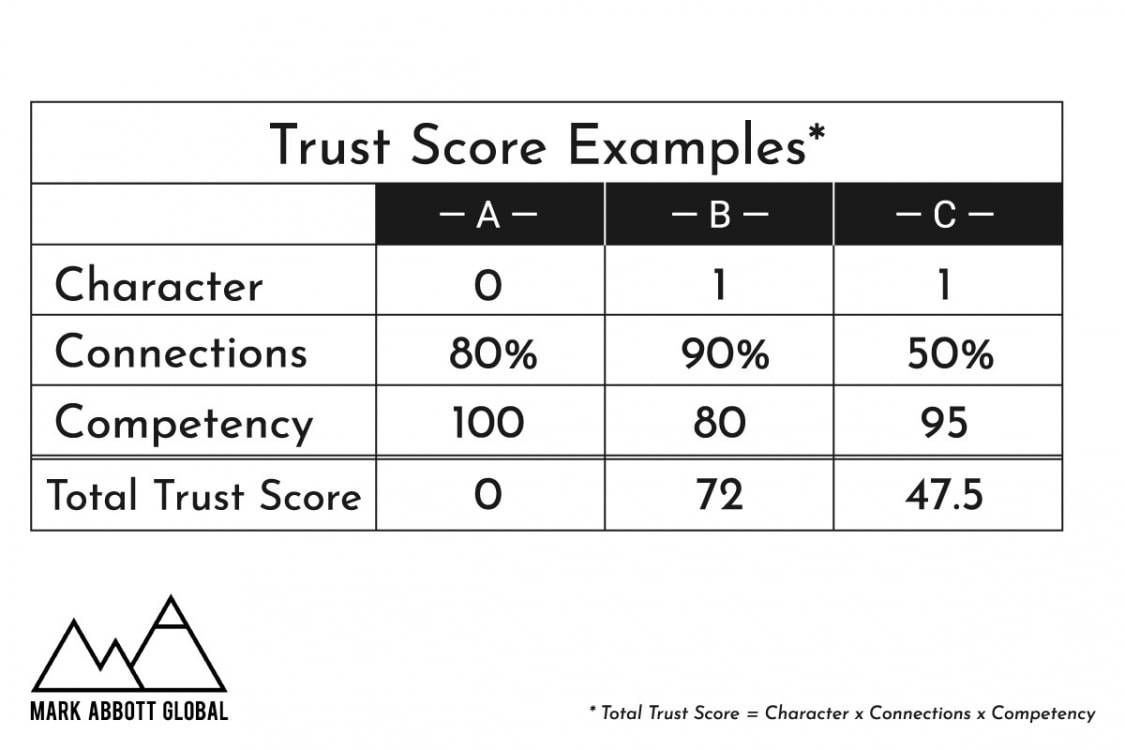Welcome to Part Four of my series of essays on Trust (and the seventh related to Work). In my previous essays, I’ve endeavored to make compelling cases for the following ideas:
- The purpose of life is to make life better;
- The best way for us to make life better is to find work we love doing (we call this Work with a capital “W”);
- We are social creatures and it is impossible for us to Work without others;
- We have seven types of relationships, every one of them matters, and it’s far easier to love life and Work when we have healthy relationships not just across all seven types but with most of, if not all, the members of each group;
- It’s almost impossible to have a healthy relationship without trust; and
- Trust has three dimensions: character, competency and connection.
One of my Work-in-progress essays is called, “It’s all Math.” The gist of the essay is it’s extraordinarily helpful to look at the math associated with virtually everything but particularly dependent and interdependent concepts.
In this essay, I’m going to introduce a simple, math-based tool (aka, a mental model — future essay on mental models to come) that I use to help me assess the health of all of my relationships. I’m a huge believer that great value can be found in identifying and understanding the math associated with any system. And, if you’ll recall from Being Human 101, healthy, long-term, relationships tend to be found when there are complementary needs, goals, values, interests, resources, and competencies.

Before we get into the math, I’m going to assume I’ve made a decent case for the proposition that there are indeed three primary dimensions of trust. That said, even if you haven’t yet fully bought into this, my hope is unpacking the math associated with assessing trust will help make my case.
One of the first things we need to do when developing the math associated with better understanding any system is determine whether the dimensions are dependent, interdependent or independent.
Let’s look at dependency first because if one is dependent on the other then my argument that we need to view these separately doesn’t stand. More specifically, if one (or more) of them is dependent then it (they) is (are) simply a subset of the other and therefore there are only two or one dimension(s) of trust.
Competency vs. Character
I trust (sorry, I love puns) you’ll grant me that it’s difficult to make a case that character-based trust is a subset of competency-based trust given we are born incompetent but social. Likewise, I hope you’ll grant me there are lots of people who are extraordinarily competent, but we know we cannot trust character wise.
Character vs. Connections and / or Competency
In terms of the argument that character-based trust is a subset of connections-based trust, I get how one could be tempted to make this argument. That being the case, I suspect you’ll find there are potentially millions of examples where people of both good character, and a high degree of competency, possess a very different set of values; so different in fact that it appears almost impossible for them to trust one another (e.g., think of people who deeply value unalienable individual rights versus those who deny the existence of one or more of those rights).
Competency vs Connections and / or Character
Similarly, I get how one could be open to the idea that competency-based trust is a subset of connections-based trust, given competency is almost always acquired with the help of others directly or indirectly, except this exercise is specifically about trust and every one of us is incompetent across a whole host of skills and areas of expertise therefore we are all incompetent in one way or another but that doesn’t mean we are all untrustworthy in terms of character or connections based trust.
Consequently, I believe one can be totally trustworthy when viewed through the lenses of character and connections but utterly incompetent and that competency (e.g., Work) is essential for scaling Maslow’s Hierarchy not just at the individual but group, company, community and national levels (otherwise, why not just have a lottery for all areas of work / Work including even the President of the United States?). Consequently, I submit it makes good sense to understand and assess trust through all three lenses.
Next up is the question concerning whether or not the three forms of trust are independent or interdependent? What follows is a simple three column chart where I not only lay out the typical factors / traits associated with each form of trust, but I’ve added some colored boxes around traits that I think are fairly interdependent. The purpose of this diagram is not to lay out all the interdependencies but simply to provide enough “food for thought” as to make a decent case that the three dimensions are interdependent. Let’s take a look at the chart and then I’ll expound on one of the interdependent examples.
How the Three Dimensions are Interdependent

As you can see, one of the interdependencies examples is Intent, Agreements and Reputation. As you may note, I have allocated Agreements to the connections column. While one could argue that Agreements are simply a subset of integrity, I submit there are a lot of people who we would all deem of high integrity but who don’t live up to their agreements. As I mentioned in About Trust: Part Two, one my favorite coaching lessons is based upon Steve Chandler’s “Expectations versus Agreements” where I riff on how things like roles and responsibilities, measurables (aka key performance indicators), to-do’s, rocks (aka 90 day goals), core values and more are all agreements and how few people fail to see them as genuine, “we live up to these”, agreements and respect them as such.
Consequently, I would submit most people (I’ve coached over 100 teams) don’t live up to all of their agreements even though I think most people would think of themselves as being of high integrity.
Fact is, most of us don’t take all of our agreements as seriously as we should in part because we don’t give them as much thought as we should or that our culture values agreements less than relationships (future trust essay coming on monochronic versus polychronic cultures — I know, I’m such a geek). Part of the reason we tend to be OK not living up to our agreements is we also work in tribes where our reputation is not going to suffer much, if at all, if we don’t live up to our agreements (no one else does — especially my boss). That said, some tribes take their agreements very seriously (monochronic cultures much more than polychronic) and as a consequence I think agreements are related to integrity and competence but not quite either.
I can immediately provide a handful of other examples of interdependencies but I hope the prior will suffice for the purposes of making the case that the three dimensions of trust are interdependent, and that these interdependencies are one of the main reasons trust is such a complicated thing.
Final thought before we move back on to the math of trust….
I don’t believe which category something “sits in” is all that important. As far as I’m concerned, you can add a trait to more than one category or move some from one category to another. It doesn’t fundamentally alter our ability to understand, measure and talk about trust. What’s important is understanding that:
- Trust is a complicated thing (duh);
- Character-based trust is best initially assumed / given (Ronald Reagan famously said: “Trust first, then verify”) and then lost;
- Competency-based trust is either earned or authenticated;
- Connections-based trust is typically developed overtime or assumed based upon the tribes “brand”; and
- Whether given, earned or developed, all three forms are easily lost and very hard to rebuild.
The Math of Trust
Let’s now unpack more of the math associated with trust…

I love simple tools and systems.
In terms of assessing the trust levels of our relationships, I’d love to have a simple tool (it’s really a model but models are tools) that makes it fairly easy to assess, rate and get really open and honest about how we are doing in terms of building high trust relationships (including with ourselves!) and High Trust Companies (HTCs).
To make this exercise even more interesting, I submit that the three dimensions of trust are interdependent, I think there’s an opportunity to create a total trust score that’s based upon multiplying a rating / score for each of the three dimensions. As an example, we could go 0–10 across all three dimensions and have a trust score like a baseball batting average (i.e., 10 times 10 times 10 which would give us a trust score range of 1 to 1,000).
While I love simple, I don’t think 1- 10 is appropriate, or needed, for each of the dimensions. More specifically, if we don’t trust someone’s character does their competency or connections trust score matter at all? And if that’s pretty true, what’s the simplest trust rating system for character: yes, no, don’t know? What do we do if the answer is I don’t know? I submit, based upon the theory of “trust first” for character, we assume “yes” and hence it’s just “yes” or “no” and consequently the scoring system is super simple: yes = 1, no = 0.
Are the trust rating scores for connections and competency the same? Competency could easily be 0–10 or 0–100. I’ve been using a rating system for years that will work with either range (upcoming essay).
What about connections then? I like “+2” to “-2” with “+2 being very strong and -2 being very bad. I also like 50% being neither good nor bad and 100% being great and 0% obviously being awful.
So… here is where the math of trust that I’ve landed on subject to feedback:
- Yes (1), no (0) for character (first score, if you’re rating someone a zero why even think about the other scores),
- 0–100% for connections (50% being no real connection, 100% being great, 0% being horrible), and
- 0–100 (number not percentage) for competency (future easy on why this range makes sense and how to assess it).
I’ve ordered these intentionally:
- Character first: if you’re rating someone a zero why even think about the other scores?
- Connections: in the long run, wouldn’t we all want to Work with people we genuinely want to be around and who make us better?
- Competency: I went here last because ultimately I believe it’s easier to find and or develop competency than it is character (for sure) or find people who genuinely help us become better and better versions of the best versions of ourselves.
Best case maximum rating is 100. Worst case score is 0. As far a minimum acceptable bar that’s got to be your choice. For me, I am for sure at least 80% on the connections and competency bar and there may be some categories inside of the connections (e.g., core values) where I have zero tolerance for a low score.
The chart below shows three examples of the Math of Trust, with each quality (character, connections and competency) multiplied to provide the Total Trust Score:

So…
The beauty of Medium is we’ve got this cool opportunity to have any and all of you provide feedback, comments, suggestions and recommendations for the proposed trust rating model. My hope is together, we can figure out something compelling and I’ll write about the discussions in the next essay. If we do, we’ll use the new model to help us with some of our future essays on trust. If we don’t, I’ll use the system I’ve proposed — at least for now. Game on?
Awesome!
Executive Summary
- Great value can be found in identifying and understanding the math associated with any system.
- There are three primary dimensions of trust, and applying math makes it clear that the dimensions are interdependent.
- While most people see themselves as having high integrity, many don’t take their agreements as seriously as they should. Right or wrong, this occasionally adversely impacts their total trust score.
- The Math of Trust takes Character (yes or no, 1 or 0) times Connections (zero to 100%) times Competency (on a scale of 0 to 100). This simple tool allows us to better assess the trust levels of our relationships and more importantly makes it almost easy to talk about trust in terms of what’s working and needs work.



